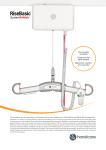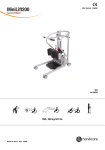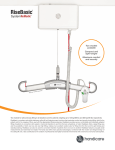Download User manual AmpHBSling EN INT
Transcript
AmpHBSling Manual - English SystemRoMedic TM Max load: 300kg/660lbs AmpHBSling is easy for the caregiver to apply and it gives the patient a feeling of security. It features leg sections, which means that the patient does not sit on the sling. Instead, the sling provides support from the tailbone up over the head and under the legs. AmpHBSling has been designed for the most common lifting situations, even where a sling without separate leg sections is preferred; e.g., when lifting a patient with high double leg amputations. SystemRoMedic includes a wide range of functional, comfortable, high-quality slings that can be adapted for different types of lifting and for patients with different needs. The slings are available in several different materials and in sizes from XXS to XXL. All models are safe and very easy to use and are rated for lifting patients weighing up to 300 kg. The choice of model and material depends on the patient’s needs and the transfer situation. Functional inspection Visual and mechanical inspection Check the condition and function of the sling regularly. Always inspect the product after laundering. Check to ensure that seams and material are free from damage. Check to ensure that fabric is not worn or faded. Apply load to the device and check to ensure that clasps, handles, etc. withstand heavy load. If there are signs of wear, the product must be discarded. Always read the manual Always read the manuals for all assistive devices used during a transfer. Keep the manual where it is accessible to users of the product. Do not leave the patient unattended during a transfer situation. To prevent discomfort and the risk of the patient sliding out of the sling, trial fit the sling carefully. First, apply the sling’s back loops to the slingbar, and then apply the leg support loops. Use a slingbar that has been tested. The lowest allowable safe working load always determines the safe working load of the assembled system. Always check the safe working loads for the lift and accessories before use. Contact your dealer if you have any questions. Manual no: 646 En ver. 1 150429 Application of the sling when the patient is sitting in a wheelchair/chair or in bed 1. Hold the sling in one hand and place your other hand in the pocket at the lower edge of the sling. This is easier if the patient leans forward or can be helped to lean forward slightly. Guide the sling down behind the patient’s back, by sliding it along the back of the chair/wheelchair or along the bed, ideally, to the tailbone. The mid-section of the sling should follow the patient’s 1 spine. 2 2. Take care to guide the sling down to the patient’s hips. Do this by pushing the sling into the space in the back corners of the wheelchair seat. 3. Pull the leg supports out along the outside of the thighs. Sit facing the patient and pull the lower edge of the leg support, so that the sling slides into place around the hips. Light pressure against the patient’s knees prevents him/her from sliding forward in the chair. 4. After checking to ensure that the leg supports are of equal length on both 4 sides, place them under the patient’s thighs. Normally, both leg sections are placed under both of the patients’ 3 thighs. Pass the leg support through the guide loops on the edge of the sling. Start raising the slingbar, and then stop Removal of the sling when the patient is sitting to ensure that everything is as it should be before lifting the patient from the underlying surface. Fold the leg support and allow it to slide under itself when you pull it out at the outside of the thigh. Then, pull the sling up behind the patient’s back. 2 M A N U A L SystemRoMedic TM Application of the sling when the patient is lying in bed, on a stretcher or on the floor 1. Turn the patient towards you. Place the sling so that the product label is facing the underlying surface and the sling’s mid-section follows the spine. The upper edge of the sling’s back section should be at shoulder height and the lower edge level with the tailbone. Place the edge of the sling as far in under the patient as possible. Push 1 the back-section loop under, so that 2 you can reach it once you have turned the patient back onto the sling. 2. To reduce the number of application steps, you can fold the back section up against the patient’s back and place the leg supports between the patient’s knees when he/she is turned towards you, and then pull them forward when the patient is lying on the sling. 3. Turn the patient back onto the sling 4 and pull out the back section and leg support. The leg supports are now 3 overlapped under the patient. 4. Pass the leg support through the guide loops on the edge of the sling. OBS! Start raising the slingbar, and then stop Never hook the guide loops to ensure that everything is as it should to the slingbar. be before lifting the patient from the underlying surface. Removal of the sling when the patient is recumbent Turn the patient towards you and fold the sling in under the patient so that the fabric slides towards you when you pull it out after you have turned back the patient. SystemRoMedic M A N U A L TM 3 Alternative applications of the sling’s leg supports 1 3 2 1. The leg supports are placed, overlapped, under the legs and passed through the guide loops at the edge of the sling. 2. Turn the patient towards you and fold the sling in under the patient so that the fabric slides towards you when you pull it out after you have turned back the patient. 3. You can even choose not to cross the leg supports. Note, however, that this entails a risk that the patient might slide out of the sling. Not recommended for those with leg amputation at the knee or higher up. Material: Polyester: Durable material with low friction. Withstands high laundry temperatures. Polyester net: An airy material that can be left under the patient, if necessary. Withstands high laundry temperatures. Care of the product: Do not use rinsing agent. To prolong product life, avoid Read the product label. tumble-drying. Size information Slings can often be used for both 2 and 4-point suspension. It is essential to ensure that the width of the slingbar is appropriate for the sling size and the patient’s status and capacity. Use patient-specific slings to ensure safety and hygiene. Size XS/Orange S/Red XL/Purple XXL/White bs 40-88 weight kg 20-40 35-60 33,5 35,5 38 39,5 39,5 97 100 100 17,5 19,5 23,5 27,5 45 50 60 70 inch height Sling seat cm inch measurement cm 85 10,5 27 77-132 L/Green Rec. user Sling overall M/Yellow 110-176 154-242 220-286 264,5-397 50-80 70-110 100-130 90 14,5 37 120-180 39,5 100 Contact your local distributor if you have any questions about the product and its use. See www.handicare.com for a complete list of distributors. Always make sure that you have the right version of the manual. The most recent editions of manuals are available for downloading from our website, www.handicare.com. Handicare AB Maskinvägen 17 SE-972 54 Luleå SWEDEN Tel: +46 (0)8-557 62 200 Fax:+46 (0)8-557 62 299 Internet: www.handicare.com E-mail: [email protected]










